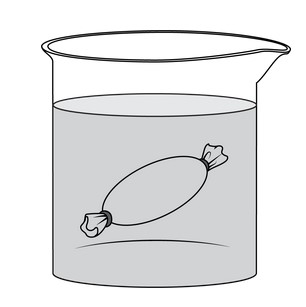Question

Figure 1
A student is using dialysis bags to model the effects of changing solute concentrations on cells. The student places one dialysis bag that contains 25 mL
of distilled water into each of two beakers that are filled with 200 mL of distilled water. (Figure 1). The membrane of each dialysis bag membrane contains pores that allow small solutes such as monoatomic ions to pass through but are too small for anything larger to pass. After 30 minutes, 5 mL
of a concentrated solution of albumin (a medium-sized, water-soluble protein) is added to one of the two beakers. Nothing is added to the other beaker. After two more hours at room temperature, the mass of each bag is determined. There is no change in the mass of the dialysis bag in the beaker to which no albumin was added.
Which of the graphs below best represents the predicted change in mass over time of the dialysis bag in the beaker to which albumin was added?
A.

B.

C.

D.

Answer/Explanation
Ans: B
The graph indicates no change in the mass of the dialysis bag for the first 30 minutes in an isotonic environment and then shows a decrease in mass when the environment became hypertonic with the addition of albumin.
Question
If the ER (endoplasmic reticulum) is completely removed from a cell, the cell can function normally for a short time but is unable to
synthesize new ER during this time. Which of the following is the most likely explanation for this phenomenon?
(A) The genes for ER synthesis are present in the ER.
(B) The ER is not an obligatory organelle in most cells.
(C) The genes for ER synthesis are irreversibly turned off once cell
development is complete.
(D) The information required to construct the ER does not reside
exclusively in the DNA.
Answer/Explanation
Ans: D
Most membrane-bound organelles can only be synthesized from
“pieces” of membrane-bound organelle. During cytokinesis, the
endomembrane system (including the golgi and ER) is divided up into
daughter cells. These fragments of membrane are used to construct new
membrane. The mitochondria and chloroplast are important exceptions.
These organelles are capable of semi-autonomous replication within cells (they used to be free-living prokaryotes). Still, organelles come from pre-existing organelles in some form.